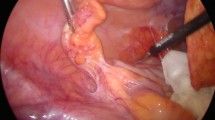Abstract
Purpose: The purpose of this study was to determine the recurrence rate of hydrosalpinges after cuff neosalpingostomy in poor prognosis candidates.
Methods: Forty consecutive patients with hydrosalpinx treated with cuff neosalpingostomy were included. Main outcome measures were recurrence rate of hydrosalpinx after cuff neosalpingostomy, intrauterine and ectopic pregnancy rates.
Results: Intraoperatively, the mean size of the hydrosalpinx was 1.9±0.7 cm, and 77% of patients had evidence of pelvic adhesions. Recurrence of hydrosalpinx, whether unilateral or bilateral was 70% (28/40) per patient. Intrauterine and ectopic pregnancy rates were 5% (2/40) and 2.5% (1/40), with a total pregnancy rate of 7.5% (3/40).
Conclusions: Most patients experience recurrence of hydrosalpinx after cuff neosalpingostomy, thus requiring additional surgery such as salpingectomy prior to in vitro fertilization (IVF). In a poor prognosis population, salpingectomy should be considered as the primary treatment for hydrosalpinx prior to IVF.

Similar content being viewed by others
References
Bahamondes L, Bueno JGR, Hardy E, Vera S, Pimental E, Ramos M. Identification of main risk factors of tubal infertility. Fertil Steril 1984;61:478–82
Katz E, Akman MA, Damewood MD, Garcia JE. Deleterious effect of the presence of hydrosalpinx on implantation and pregnancy rates with in vitro fertilization. Fertil Steril 1996;66:122–5
Kassabji M, Sims JA, Butler L, Muasher SJ. Reduced pregnancy outcome in patients with unilateral or bilateral hydrosalpinx after in vitro fertilization. Eur J Obstet Gynecol Reprod Biol 1994;56:129–32
Strandell A, Waldenstrom U, Nilsson L, Hamberger L. Hydrosalpinx reduces in-vitro fertilization/embryo transfer pregnancy rates. Hum Reprod 1994;9:861–3
Mukherjee T, Copperman AB, McCaffrey C, Cook CA, Bustilo M, Obasaju MF. Hydrosalpinx fluid has embryotoxic affects on murine embryogenesis: a case for prophylactic salpingectomy. Fertil Steril 1996;66:851–3
Beyler SA, James KP, Fritz MA, Meyer WR. Hydrosalpingeal fluid inhibits in vitro embryonic development in a murine model. Hum Reprod 1997;12:2724–8
Meyer WR, Castelbaum AJ, Somkuti S, Sagoskin AW, Doyle M, Harris JE. et al. Hydrosalpinges adversely affect markers of endometrial receptivity. Hum Reprod 1997;12:1393–8
Strandell A, Lindhard A, Waldenstrom U, Thornburn J, Janson PO, Hamberger L. Hydrosalpinx and IVF outcome: a prospective, randomized multicentre trial in Scandinavia on salpingectomy prior to IVF. Hum Reprod 1999;14:2762–9
Surrey ES, Schoolcraft WB. Laparoscopic management of hydrosalpinges before in vitro fertilization-embryo transfer: salpingectomy versus proximal tubal occlusion. Fertil Steril 2001;75:612–7
Murray DL, Sagoskin AW, Widra EA, Levy MJ. The adverse effect of hydrosalpinges on in vitro fertilization pregnancy rates and the benefit of surgical correction. Fertil Steril 1998;69:41–5
Boer-Meisel ME, te Velde ER, Habbema JDF, Kardaun JWPF. Predicting the pregnancy outcome in patients treated for hydrosalpinx: a prospective study. Fertil Steril 1986;45:23–9
Mage G, Pouly JL, de Joliniere JB, Chabrand S, Riouallon A, Bruhat MA. A preoperative classification to predict the intrauterine and ectopic pregnancy rates after distal tubal microsurgery. Fertil Steril 1986;46:807–10
Oh ST. Tubal patency and conception rates with three methods of laparoscopic terminal neosalpingostomy. J Am Assoc Gynecol Laparos 1996;3:519–23
Milingos SD, Kallipolitis GK, Loutradis DC, Liapi AG, Hassan EA, Mavrommatis CG. et al. Laparoscopic treatment of hydrosalpinx: factors affecting pregnancy rate. J Am Assoc Gynecol Laparos 2000;7:355–61
Marana R, Rizzi M, Muzii L, Catalano GF, Caruana P, Mancuso S. Correlation between the American Fertility Society classifications of adnexal adhesions and distal tubal occlusion, salpingoscopy, and reproductive outcome in tubal surgery. Fertil Steril 1995;64:924–9
Canis M, Mage G, Pouly JL, Manhes H, Wattiez A, Bruhat MA. Laparoscopic distal tuboplasty: report of 87 cases and a 4-year experience. Fertil Steril 1991;56:616–21
te Velde ER, Boer-Meisel ME, Meisner J, Schoemaker J, Habbema JDF. The significance of preoperative hysterosalpingogram and laparoscopy for predicting the pregnancy outcome in patients with bilateral hydrosalpinx. Eur J Obstet Gynecol Reprod Biol 1989;31:33–45
Schlaff WD, Hassiakos DK, Damewood MD, Rock JA. Neosalpingostomy for distal tubal obstruction: prognostic factors and impact of surgical technique. Fertil Steril 1990;54:984–90
Donnez J, Casanas-Roux F. Prognostic factors of fimbrial microsurgery. Fertil Steril 1986;46:200–4
Zeyneloglu HB, Arici A, Olive DL. Adverse effects of hydrosalpinx on pregnancy rates after in vitro fertilization embryo transfer. Fertil Steril 1998;70:492–9
Wainer R, Camus E, Camier B, Martin C, Vasseur C, Merlet F. Does hydrosalpinx reduce the pregnancy rate after in vitro fertilization? Fertil Steril 1997;68:1022–6
The practice committee of the American Society for Reproductive Medicine. Salpingectomy for hydrosalpinx prior to in vitro fertilization. Fertil Steril 2004;82:S117–9
Gomel V. Salpingo-ovariolysis by laparoscopy in infertility. Fertil Steril 1983;40:607–11
Vasquez G, Boeckx W, Brosens I. Prospective study of tubal mucosal lesions and fertility in hydrosalpinges. Hum Reprod 1995;10:1075–8
Chong AP. Pregnancy outcome in neosalpingostomy by the cuff vs. Bruhat technique using the carbon dioxide laser. J Gynecol Surg 1991;7:207–10
Dubuisson JB, de Joliniere JB, Aubriot FX, Darai E, Foulot H, Mandelbrot L. Terminal tuboplasties by laparoscopy: 65 consecutive cases. Fertil Steril 1990;54:401–3
Kitchin JD, Nunley WC, Bateman BG. Surgical management of distal tubal occlusion. Am J Obstet Gynecol 1986;155:524–9
Kosasa TS, Hale RW. Treatment of hydrosalpinx using a single incision eversion procedure. Int J Fertil 1988;33:319–23
Kodaman PH, Arici A, Seli E. Evidence based diagnosis and management of tubal factor infertility. Curr Opin Obstet Gynecol 2004;16:221–9
Author information
Authors and Affiliations
Corresponding author
Additional information
Presented at the 59th Annual Meeting of the American Society for Reproductive Medicine, October 11–15, 2003, San Antonio, Texas.
Rights and permissions
About this article
Cite this article
Bayrak, A., Harp, D., Saadat, P. et al. Recurrence of hydrosalpinges after cuff neosalpingostomy in a poor prognosis population. J Assist Reprod Genet 23, 285–288 (2006). https://doi.org/10.1007/s10815-006-9050-4
Received:
Accepted:
Published:
Issue Date:
DOI: https://doi.org/10.1007/s10815-006-9050-4




